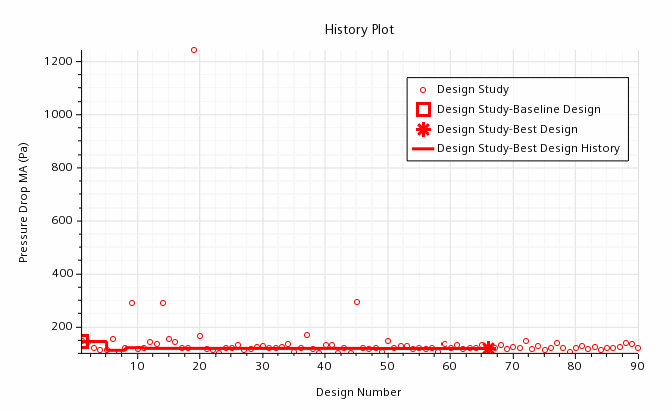You start this tutorial by loading a Design Manager project file that includes a completed optimization study for the industrial
exhaust. You then identify the best design coming from that study.
The goal for the optimization study was
to find a design that minimized the pressure drop through the system while maintaining an
outflow uniformity of at least 87%.
To load the initial optimization:-
Start up Simcenter STAR-CCM+ and select .
-
In the Load a File dialog:
-
Set Type to Design Manager
Project.
-
Click Browse.
-
In the Open dialog, navigate to the
designExploration folder of the downloaded tutorial files and
select industrialExhaust_optimization.dmprj.
-
Click Open, then OK.
-
If required, download also the reference simulation
industrialExhaust_referenceSimulation.sim.
-
To find the best design resulting from the completed optimization study:
-
Right-click the node and select .
-
In the History Plot Setup dialog, click
OK.

For each design, the history plot
shows the pressure drop across the system. The best design according to this plot is
the one that gives the lowest pressure drop.
-
In the plot, hover the mouse pointer over the asterisk. The asterisk identifies the
best design according to the objective.
In the hover text, Design 66 is listed as the best design with a
pressure drop of 116. 793 Pa.
-
Right-click the node and select Open Output
Table.
The Output Table - Feasible
table lists all designs that meet the uniformity constraint with their corresponding
input parameters and responses.
-
In the header of the table, click Performance twice to sort
the column from the highest value to the lowest.
The highest performance value identifies the best design.
For Design 66, the performance value is -0.812. Note the input
parameters for this design.
| Input Parameter |
Value |
| Bottom Angle
Path |
84.0 deg |
| Deflector Angle |
97.0 deg |
| Deflector Horizontal
Distance |
0.1 m |
| Deflector Radius |
0.31 m |
| Deflector
Translation_X |
-0.1 m |
| Deflector
Translation_Y |
-0.1 m |
| Deflector Vertical
Distance |
3.2 m |
| Top Angle Path |
77.0 deg |
You use the input parameter
values later when you define the reliability study.
